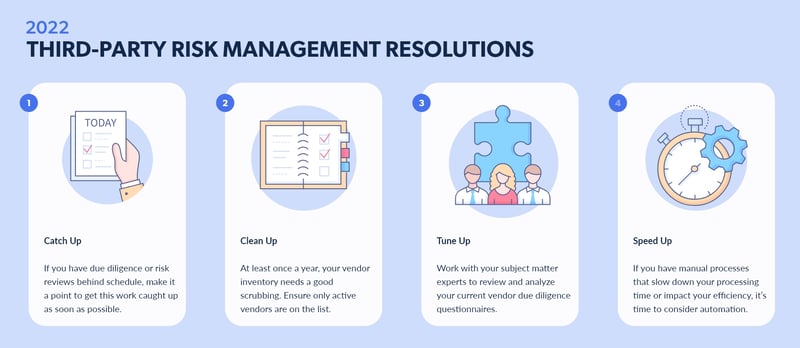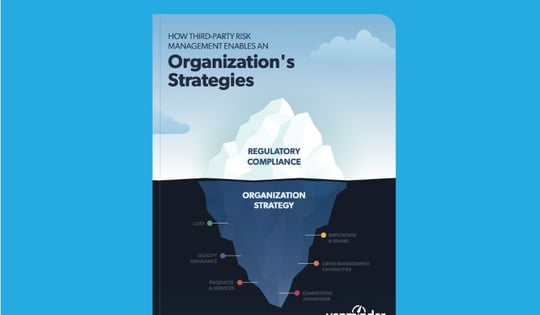As a new year draws closer, it’s time to start making resolutions for your third-party risk management (TPRM) program. With 2022 around the corner, it’s a great time to review your program for any needed improvements and consider how to achieve and maintain your TPRM goals.
Periodic Program Review Is Necessary
Best practices dictate that your TPRM program be reviewed at least annually. Your TPRM policy should be reviewed each year, along with your framework, tools, processes and procedures.
Keep these tips in mind as you review your program:
- Collaboration is key: Third-party risk management requires the involvement of stakeholders across the organization, so it’s important to make sure they have a voice in the program review. The line of business vendor owners' perspectives will likely be different from that of the TRPM team or subject matter expert and taking different viewpoints into perspective can help you identify and prioritize program improvements.
- Set a strong foundation: Remember, it isn't just about improving the program. In some cases, you may find the priority is getting your processes in shape to meet baseline standards.
- Stay informed of regulations: Reviewing your TPRM program against existing or proposed regulations is recommended to identify potential gaps and the work effort and resources required to close them.
4 Third-Party Risk Management Resolution Ideas for 2022
Each TPRM program is unique, but there should be common themes for improvement as you review the program. Here are a few resolutions you might choose in 2022 for your TPRM program… to catch up, clean up, tune up and speed up. Let’s review:

- Catch up: If you have due diligence or risk reviews behind schedule, make it a point to get this work caught up ASAP. Auditors and examiners will likely give you a finding for not meeting the due dates. Findings aside, the bigger concern is that new and emerging risks can go undetected for too long, increasing the likelihood or severity of the risk. If resources are the issue, consider outsourcing due diligence to a third-party service provider that can close the resource gap and get back on schedule.
- Clean up: At least once a year, your vendor inventory needs a good scrubbing. Check to ensure that only active vendors are on the list and the correct vendor owner is listed. Be mindful of lower-risk vendors who often work by purchase order or direct invoice instead of a contract. These vendors may be long gone and now are clutter on your inventory list. Work with your accounts payable department to harmonize any active vendor lists to ensure payments are not made to terminated vendors. Close out old records and safely archive vendor documents per your internal records retention policies.
- Tune up: Work with your subject matter experts to review and analyze your current vendor due diligence questionnaires. Make sure that the questions asked are relevant and reflect the current risk environment. Remember, a lot has changed in the last two years, and pre-pandemic questionnaires may not address the variety of new and emerging risks present today. It’s more than likely that your questionnaire could use a tune up. It’s also a good time to review the documents and other evidence you request from your vendor to ensure the latest standards are met.
- Speed up: If you have manual processes that slow down your processing time or negatively impact your efficiency, it’s a great time to consider automation. Manual processes aren't only time-consuming, but they’re also error-prone, often causing re-work and slowing the whole process further. If you aren’t using one, this could be the year you consider moving to a software-based TPRM system that can automate administrative tasks, notifications, scheduling and reporting. Automation is especially important when scarce resources are an issue.
Committing to Your Third-Party Risk Management Resolutions
Now that you have identified some to-do's for the next year, the important part is to make sure they get done. Good intentions are only as good as the effort and the action, so keep the following in mind to help stay on track:
- Identify and prioritize the drivers for improvement. When time and resources are limited, you must prioritize improvements by impact. For example, if your due diligence process doesn’t meet regulatory standards, fixing that issue must take precedence over something less impactful such as reformatting TPRM reports.
- Formalize the improvement as a project. Make sure you have a work plan, roles and responsibilities and a formal schedule. Report on your progress and keep everyone accountable.
- Develop a roadmap of improvements you’ll make during the year. Note which projects have predecessor dependencies and the order in which they must be done. For example, you can't generate vendor performance reports until vendor key performance indicators (KPIs) are established. The roadmap should be created annually and show the plan for continuous improvement and optimization.
The truth is that improving and optimizing your TPRM program can occur at any time, but starting the new year with a fresh plan is often re-energizing and gives many of us that sense of focus necessary to accomplish the tasks at hand. Make 2022 the year your program achieves better performance, efficiency and effectiveness by setting your TPRM resolutions now.


















